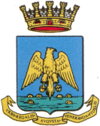Augusta, Sicily
| Augusta | ||
|---|---|---|
| Comune | ||
| Comune di Augusta | ||
|
| ||
| ||
 Augusta Location of Augusta in Italy | ||
| Coordinates: 37°15′N 15°13′E / 37.250°N 15.217°ECoordinates: 37°15′N 15°13′E / 37.250°N 15.217°E | ||
| Country | Italy | |
| Region | Sicily | |
| Province | Syracuse (SR) | |
| Frazioni | Agnone Bagni, Brucoli | |
| Government | ||
| • Mayor | Maria Concetta Di Pietro (Five Star Movement) | |
| Area | ||
| • Total | 111.16 km2 (42.92 sq mi) | |
| Elevation | 15 m (49 ft) | |
| Population (30 November 2017[1]) | ||
| • Total | 35,854 | |
| • Density | 320/km2 (840/sq mi) | |
| Demonym(s) | Augustani | |
| Time zone | UTC+1 (CET) | |
| • Summer (DST) | UTC+2 (CEST) | |
| Postal code | 96011 | |
| Dialing code | 0931 | |
| Patron saint | St. Dominic | |
| Saint day | May 24 | |
| Website | Official website | |
Augusta (Sicilian: Austa, Greek and Latin: Megara Hyblaea, Medieval: Augusta and Agosta) is a town and comune in the province of Syracuse, located on the eastern coast of Sicily (southern Italy). The city is one of the main harbours in Italy, especially for oil refineries (Exxon Mobil and others as part of the complex Augusta-Priolo) which are in its vicinity.
Geography
The city is situated in the province of Syracuse and faces the Ionian Sea. The old town is an island, made in the 16th century by cutting an isthmus and is connected to the mainland by two bridges. One bridge was built recently (Viaduct Frederick II of Swabia) and the other built when the city was founded and is called the Spanish Gate. Augusta is home to two ports.
History
Founded 27 centuries ago, Megara Hyblaea is one of the oldest Greek colonies of Sicily. It was destroyed by its rival Syracuse, was raised from its ruins, then taken by the Romans together with Syracuse during the Second Punic War. It remains an archaeological site, a testimony of the organization of a Greek colony of the Archaic period.
Upon the ruins of one of its suburbs, Xiphonia, the city of Augusta was founded in 1232 by Emperor Frederick II. After the Angevin domination, it became part of Aragonese Sicily and, from 1362, it was a fief of Guglielmo Raimondo II Moncada. It returned to be a royal possession (under Spain) in 1560, and was extensively fortified to counter Turkish pirates.
In 1675 its harbour was the site of a naval battle between the Dutch-Spanish and the French fleets. The town suffered a major earthquake and tsunami in 1693.[2] During World War II, Augusta was captured on July 13, 1943 by the British Eighth Army led by Britain's General Montgomery.
Main sights

.jpg)
- Castello Svevo (Hohenstaufen Castle, built c. 1232). It has a square plan of a 62-metre (203 ft) side length, with eight towers
- Capo Santa Croce Lighthouse
- Church of Anime Sante del Purgatorio (S. Nicolò). The Baroque façade is attributed to Filippo Juvarra
- Church of Carmine
- Church of Cristo Re
- Church of Maria Santissima Assunta (Augusta)
- Church of Maria Santissima del Soccorso
- Church of Sacro Cuore
- Church of San Domenico (13th century). The façade is in Neoclassical style
- Church of San Francesco di Paola
- Church of San Giuseppe
- Church of Santa Maria delle Grazie
- Church of Santa Maria del Soccorso
- Church of San Sebastiano
- Church of Sant'Andrea
- Church of Santa Lucia
- Convent of the Domenican Fathers
- Eremo Adonai
- Forti Garsia e Vittoria
- Hangar dirigibili Augusta
- Kursaal Augusteo
- Porta Spagnola
- Ricetta di Malta
- Spanish Gate (17th century)
- Torre Avalos
People
- Rosario Morello, engineer
- Emanuele d'Astorga, composer
- Danilo Conti, philosopher, astronaut
- Orso Mario Corbino, physicist
- Epicarmo Corbino, economist
- Giuseppe Di Mare, organist, pianist and composer
- Rosario Fiorello, showman
- Beppe Fiorello, actor
- Alfredo Maria Garsia, Bishop of Caltanissetta
- Marcello Guagliardo Giordani, opera singer (tenor)
- Giovanni Lavaggi, Formula 1 driver
- Roy Paci, musician
- Antonio Scaduto, canoeist
- Riccardo Schicchi, director
- Chiara Strazzulla, writer
- Vintario Brusconti, writer (fictional)
- Francesco Saia, baller, wine aficionado
References
- ↑ Data from Istat
- ↑ Catalogue of tsunamis generated in Italy and in Cote d’Azur, France:a step towards a unified catalogue of tsunamis in Europe, Stefano Tinti and Alessandra Maramai - 1693 1 9 - Eastern Sicily Anomalous sea movement at Augusta and 1693 l 11 - Eastern Sicily Large sea withdrawal and flooding at Augusta
External links
| Wikimedia Commons has media related to Augusta (Italy). |

